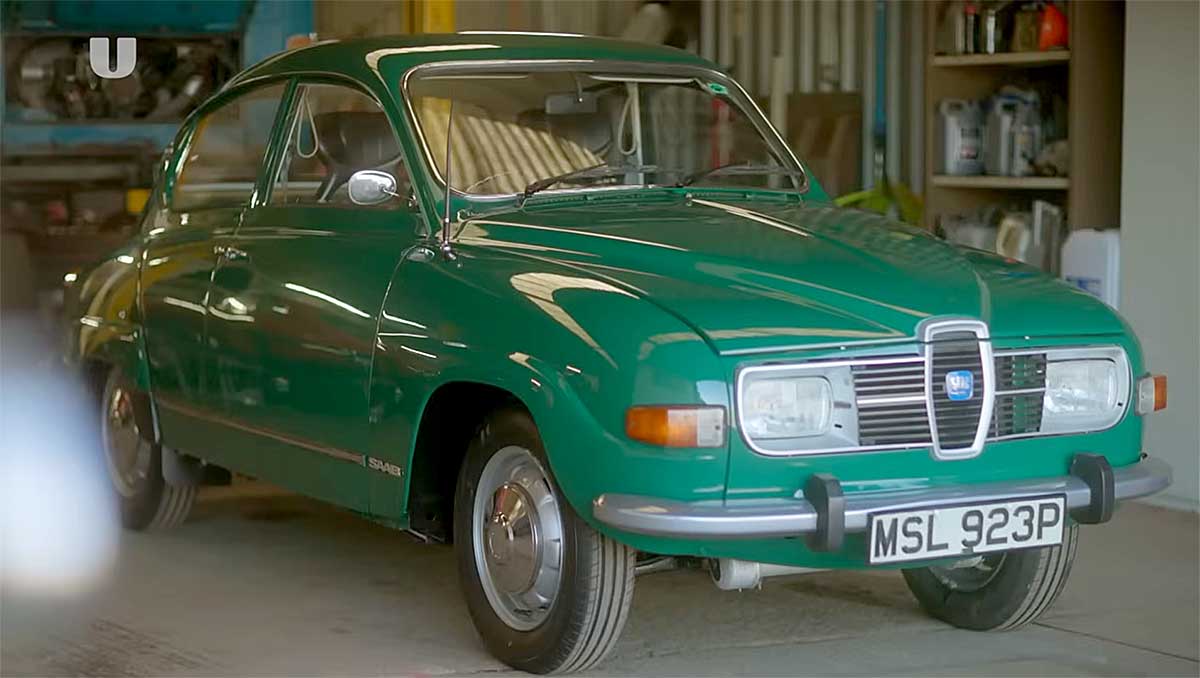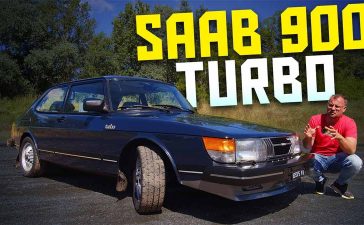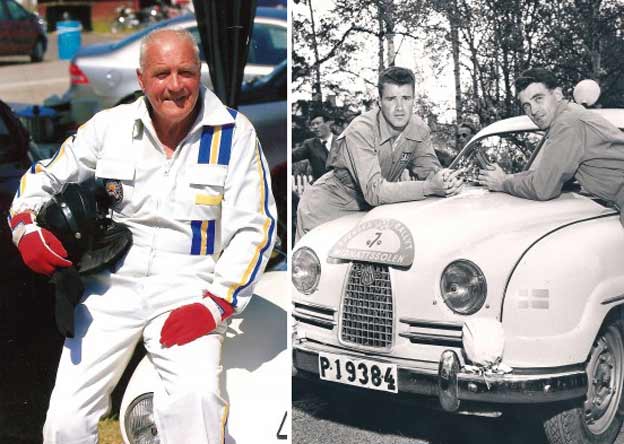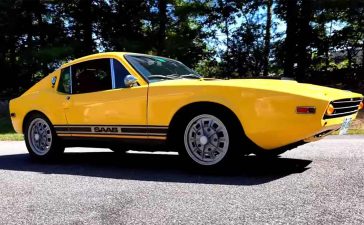A Saab 96 With A Family Story At Its Core
The Saab 96 chosen by the Bangers & Cash team wasn’t just another auction find. It carried decades of family history, dating back to its original purchase in 1976. The seller spoke with visible emotion, recalling how the car transported his mother, father, and even acted as a bridal car for a cousin’s wedding in 1977.
For nearly fifty years, the green V4 stayed in the same family. Memories clung to its upholstery – the smell of the interior, snapshots of holidays, the gentle patina of use. It was a living archive of moments that defined family life in the 1970s and ’80s. The seller’s wish was simple: let the Saab go to someone who would cherish it, restore it, and hopefully put it back on the road.
That emotional weight is exactly what drew Mathewsons, the family-run Yorkshire auction house at the center of Bangers & Cash, to take a chance on the car. At £3,100, it seemed like a smart project. But the Saab 96 would soon reveal just how deceptive first impressions can be.
The Auction Gamble: A Saab That Looked Straight
At the gavel’s drop, the Saab 96 appeared to be a tidy one-family-owner car – straight, honest, and apparently just needing light recommissioning. The brakes were free, the engine showed signs of life, and apart from a tired rear seat and tired paint, optimism was high.
But Saab veterans will know: a 1970s 96 is rarely without corrosion. Its rally pedigree – Eric Carlsson’s victories in Monte Carlo and the RAC Rally – may have proven the model’s resilience, but everyday road cars were still at the mercy of British winters, salted roads, and the inevitable creeping rust.
The Mathewsons crew sent the car to a trusted restoration workshop in Croft, North Yorkshire. There, the romantic dream of a “quick mechanical tidy-up” would be replaced by the cold reality of welding sparks, filler dust, and invoices that kept climbing.
Rust Never Sleeps: The Reality Of Stripping A Saab 96
Once the Saab hit bare metal, the extent of its decay became undeniable. Floorpans crumbled, inner arches dissolved at the touch of a wire wheel, and door bottoms revealed rot hiding under paint. Even sections of the boot floor and rear wings were discovered to be little more than filler held together by hope.
Mechanics described the pipes as “crispy,” rubber perished to the point of disintegration, and panels so thin they needed to be fabricated from scratch. Every Saab enthusiast watching at home likely nodded knowingly – this was no surprise for a half-century-old Swedish survivor.
The team faced the classic restorer’s dilemma: patch and preserve, or strip everything to bare metal and rebuild as if the car had just rolled out of Trollhättan. They chose the latter. What began as a cost-controlled tidy-up turned into the first full bare-metal restoration attempted on the Restoring Classics spinoff. Passion, not profit, was now the only goal.
The Engine And Mechanics: A Compact V4 Saved By Oil Leaks
Beneath the bonnet, the Saab 96 carried its Ford-sourced Cologne V4, the replacement for the earlier two-stroke engines. Compact and light, the V4 gave the Saab better reliability and broader appeal. Originally rated at 65 horsepower, the little motor looked tired but intact.
Once stripped down, years of grime and oil sludge poured away, ironically evidence of what kept the unit alive. The engine’s many oil leaks had unintentionally preserved it by coating its internals against corrosion. New gaskets, a full clean, and careful rebuilding would be enough to restore function. When power was reconnected, it fired almost immediately – a satisfying moment in a restoration that otherwise felt like a financial black hole.
It was proof of Saab’s sturdy engineering philosophy: while bodywork might fail, the mechanical heart was always willing to return to life.
Bare Metal, Fresh Paint, And Reassembly
The workshop pressed ahead with the bodywork, fabricating panels that could no longer be sourced. Rear arches, door skins, and shock absorber mounts were painstakingly recreated. Welding consumed weeks, with each new panel revealing another hidden rust trap.
Finally, epoxy primer and a chip-resistant bed liner coated the underside, giving the Saab a fighting chance at another few decades of survival. The body received three coats of Scandinavian green, while bumpers were powder-coated instead of re-chromed, saving money without compromising finish.
Suspension rebuilds followed, including the perilous task of compressing Saab’s coil springs – described by mechanics as “bomb disposal without the training.” Seats were repaired, glass refitted, and the V4 engine returned to a freshly painted bay. Six months of labor later, a factory-fresh Saab 96 stood gleaming in the workshop!
Emotional Reunion: A Family Sees Their Saab Again
For the family who had owned the car since 1976, the reveal was deeply emotional. Seeing the Saab reborn sparked smiles, memories, and even tears. “It looks brand new,” one family member said, overwhelmed by the transformation.
This wasn’t just a vehicle – it was a time machine, carrying the weight of family weddings, road trips, and everyday life. The restoration had given them back not just a car, but a living symbol of their past.
For Saab enthusiasts, this was the moment that justified every penny and every hour spent. Restoring a 96 isn’t only about market value – it’s about cultural value, about saving a slice of Scandinavian automotive history.
The Cold Numbers: £46,000 Into A £22,750 Saab
Then came the hard truth. Restoration costs spiraled to £46,425 (!) – including nearly 4,000 pounds in parts and more than 800 hours of labor (!). At auction, the freshly restored Saab sold for £22,750.
Financially, it was a disaster. Even with bidding enthusiasm, the hammer price recouped less than half of the investment. As Derek from Mathewsons admitted, restoring any car with a resale value under £50,000 rarely stacks up. You can pour the same money into a Jaguar E-Type and turn a profit; with a Saab 96, passion is the only justification.
Yet for enthusiasts, the value wasn’t measured in profit. A Saab 96 had been saved from rust’s final victory. It was resurrected to inspire another generation, even if the ledger sheet bled red ink.
For those who want to witness the entire emotional journey—from the first glimpse of the one-family-owner Saab, through bare-metal restoration, to the final hammer falling at auction—the full 25-minute Bangers & Cash: Restoring Classics episode is available to watch. It captures every setback, every triumph, and the ultimate bittersweet result:
What This Saab 96 Restoration Means For Enthusiasts
The Saab 96 is not a car restored for speculative gain – it’s restored because it matters. It matters to motorsport history, thanks to Eric Carlsson’s rally triumphs. It matters to families, who drove them across Europe through the 1960s and ’70s. And it matters to Saab culture, because each surviving car represents a defiant act against time and neglect.
The Bangers & Cash restoration highlighted both the romance and the hard reality of saving old Saabs. Costs will always exceed market value. Rust will always be worse than expected. But the reward – the sight of a 96 gleaming again, the thrum of its V4 firing up, the smile on the face of someone whose life was once shaped by that very car – cannot be priced.
For SaabPlanet readers, the lesson is familiar: restoring Saabs isn’t about flipping cars for profit. It’s about preserving stories, craftsmanship, and identity. That makes the £46,000 Saab 96 not a financial folly, but a cultural triumph.












Wer Interesse an so alte Saab hat solte vielleicht sich die Zeit nehmen und auf YouTube sich das neue Videos von SAABastian an schauen . Die verlosen da einen 96 .